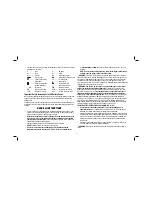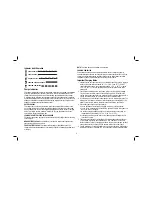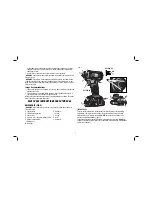
9
NOTE:
Continuous use in variable speed range is not recommended. It may damage
the switch and should be avoided.
Forward/Reverse Control Button (Fig. 2)
A forward/reverse control button (B) determines the direction of the tool and also
serves as a lock-off button.
To select forward rotation
, release the trigger switch
and depress the forward/reverse control button on the right side of the tool.
To select
reverse
, release the trigger switch and depress the forward/reverse control button on
the left side of the tool. The center position of the control button locks the tool in the
off position. When changing the position of the control button, be sure the trigger is
released.
NOTE:
The first time the tool is run after changing the direction of rotation, you may
hear a click on start up. This is normal and does not indicate a problem.
Worklights (Fig. 2)
There are three worklights (G) located around the chuck collar (C). The worklights
are activated when the trigger switch is depressed, and will automatically turn
off 20 seconds after the trigger switch is released. If the trigger switch remains
depressed, the worklights will remain on.
NOTE:
The worklights are for lighting the immediate work surface and are not
intended to be used as a flashlight.
FIG. 4
C
D
FIG. 5
C
D
Quick-Release Chuck (Fig. 2, 4, 5)
NOTE:
The chuck accepts 6.35 mm (1/4") hex accessories and 25.4 mm (1") bit tips
only.
Place the forward/reverse button (B) in the lock-off (center) position or remove battery
pack before changing accessories.
To install an accessory
, fully insert the accessory. The accessory is locked into place
(Fig. 4).
To remove an accessory
, pull the chuck collar (C) away from the front of the tool.
Remove the accessory (Fig. 5).
Anvil With Detent Pin (Fig. 2)
DCF880-XE
Place the switch in the locked off (center) position or remove battery pack before
changing accessories.
To install a socket on the anvil,
align the hole in the side of the socket with the detent
pin (L) on the anvil (K). Press the socket on until the detent pin engages in the hole.
Depression of detent pin may be necessary to aid installation of socket.
WARNING:
Use only impact sockets. Non-impact sockets may break and cause a
hazardous condition. Inspect sock et prior to use to ensure that it con tains no cracks.
To remove a socket,
depress the detent pin through the hole and pull the socket off.
Usage
Your impact tool can generate the following output torque:
Cat
#
Ft.-Lbs.
In.-Lbs.
Nm
DCF880-XE
150
1800
203
DCF885-XE
117
1400
155
CAUTION:
Ensure fastener and/or system will withstand the level of torque
generated by the tool. Excessive torque may cause breakage and possible personal
injury.
1. Place the socket on the fastener head. Keep the tool pointed straight at the
fastener.
2. Press switch to start operation. Release switch to stop operation. Always check
torque with a torque wrench, as the fastening torque is affected by many factors
including the following:
• Low voltage, due to a nearly discharged battery, will reduce fastening torque.
• Failure to use the correct socket size will cause a reduction in fastening torque.


































